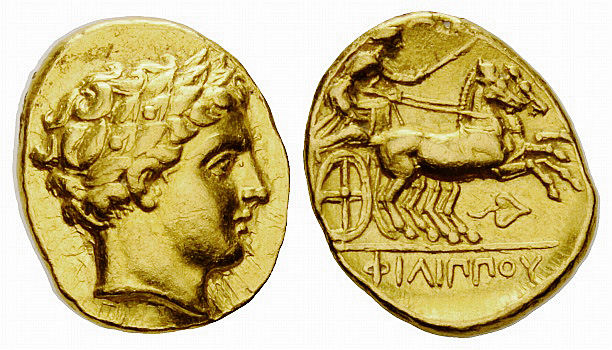H 99 - Amphipolis (Philip II), gold, staters (323-315 BCE)
From SILVER
323 BCE - 315 BCE Gold 75,240 kg
Description
| ObverseInscription or printing placed on the obverse.: | Head of Apollo right, wearing laurel wreath. |
| ReverseInscription or printing placed on the reverse.: | ΦΙΛΙΠΠΟΥ (Greek).Charioteer driving biga right, ivy leaf below |
Mint and issuing power
| MintIdentifies the place of manufacture or issue of a numismatic object.: | Amphipolis | Ancient regionAncient region.: | Macedon | Modern countryModern country: Greece | AuthorityIdentifies the issuing power. The authority can be "pretended" when the name or the portrait of X is on the coin but he/she was not the issuing power. It can also be "uncertain" when there is no mention of X on the coin but he/she was the issuing power according to the historical sources: | Alexander III the Great (Argead king, 336-323 BC), Philip II (Argead king, 359-336 BC) |
Chronology
| FromIdentifies the initial date in a range assigned in a numismatic context. | 323 BCE | toIdentifies the final date in a range assigned in a numismatic context.. | 315 BCE | PeriodTime period of the numismatic object.: Hellenistic 323-30 BC |
Physical description
| MetalThe physical material (usually metal) from which an object is made.: | Gold |
Median weightMedian of the weights of numismatic objects (in grams). in grams | 8.55 | DenominationTerm indicating the value of a numismatic object. Examples: tetradrachm, chalkous, denarius.: | stater |
StandardStandard.: | Attic |
Image

H99 Amphipolis.jpeg [1]
References
| Die study referencePublication of the study: | Le Rider 19771Le Rider 1977 | ||
| Coin series referenceReference to coin series study: | RQEMH2RQEMH, n° 99 | ||
Obverse dies distribution
| FrequencyFrequency of specimen in distribution. ᵖ | Number of obversesNumber of obverse dies. ᵖ (o) | % (o) | Number of coinsNumber of coins. (n) | % (n) | Die nameName(s) of the die(s). |
| 1 | 15 | 38.46 | 15 | 8.33 | 83, 84, 89, 90, 96, 98, 103, 104, 107, 109, 110, 114, 115, 116, 118 |
| 2 | 7 | 17.95 | 14 | 7.78 | 85, 105, 108, 111, 112, 113, 117 |
| 3 | 1 | 2.56 | 3 | 1.67 | 94 |
| 4 | 6 | 15.38 | 24 | 13.33 | 82, 88, 92, 97, 100, 106 |
| 5 | 1 | 2.56 | 5 | 2.78 | 95 |
| 6 | 2 | 5.13 | 12 | 6.67 | 87, 99 |
| 9 | 3 | 7.69 | 27 | 15 | 80, 93, 102 |
| 14 | 1 | 2.56 | 14 | 7.78 | 86 |
| 15 | 1 | 2.56 | 15 | 8.33 | 91 |
| 16 | 1 | 2.56 | 16 | 8.89 | 81 |
| 35 | 1 | 2.56 | 35 | 19.44 | 101 |
| Total | 39 of 39 | 99.97 | 180 of 180 | 100 |
Reverse dies distribution
no distribution is available
Quantification
| Number of obversesNumber of obverse dies. ᵖ (o) | 39 | Number of singletons (o1)The number of singleton coins. ᵖ | 15 |
| Number of reverse diesNumber of reverse dies. (r) | 89 | Number of coinsNumber of coins. (n) | 180 |
| Coins per obverse dieNumber of coins per obverse die. (n/o) | 4.62 | Coins per reverse dieNumber of coins per reverse die. (n/r) | 2.02 |
| Reverse per obverse ratioRatio of obverse dies divided by reverse dies. (r/o) | 2.28 | Percentage of singletons (o1)number of coins (n) divided by the number of singletons (o1) ᵖ | 38.46 % |
| Original number of dies (O) (Carter 1983 formula)The estimation of the number of coins according to Carter 1983 ᵖ | 44 | Coins struck if 20,000 as average productivity per dieCoins made if the average productivity for obverses (according to Carter) is 20,000. ᵖ | 880,000 |
| Original number of dies (O) (Esty 2011 formula)The estimation of the number of coins according to the singleton formula in Esty 2011 ᵖ (O) | 49.79 | Survival rate if 20,000 as average productivity per dieSurvival rate if average productivity is 20,000. ᵖ | 0.00020 |
| Coverage (o = % of O) (Esty 1984 formula)Esty 1984 - coverage (% of O) ᵖ (o = % of O) | 91.67% | Die productivity if survival rate 1/2,000Average productivity if survival rate is 1/2,000. ᵖ | 8,181.82 |
| Weight of silver (in kg) if 20,000 coins per die (O = Carter formula)Carter 1983 * Median weight * 20000 (*10 if gold or electrum) ᵖ | 75,240 kg <br /> 75,240 kg | Die productivity if survival rate 1/5,000Average productivity if survival rate is 1/5,000. ᵖ | 20,454.55 |
Remarks